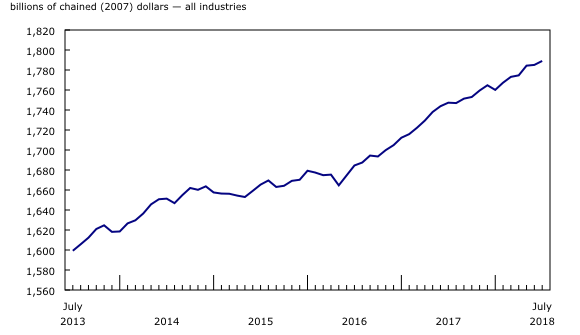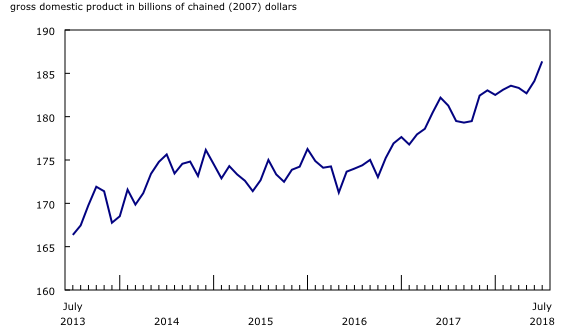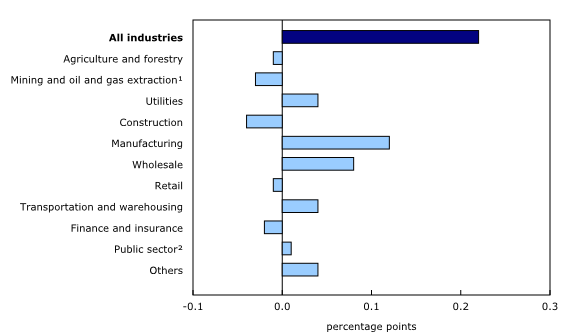Gross domestic product by industry, July 2018
Archived Content
Information identified as archived is provided for reference, research or recordkeeping purposes. It is not subject to the Government of Canada Web Standards and has not been altered or updated since it was archived. Please "contact us" to request a format other than those available.
Released: 2018-09-28
July 2018
0.2% 
(monthly change)
Real gross domestic product (GDP) grew 0.2% in July after essentially no change in June. This increase was concentrated as 12 of 20 sectors were up, led by growth in manufacturing, wholesale trade, utilities and transportation and warehousing.
The output of goods-producing industries expanded 0.3% after edging down in June, while services-producing industries were up 0.2%.
Manufacturing grows
The manufacturing sector was up 1.2% in July, its strongest growth since November 2017, as output of both non-durable and durable manufacturing rose.
Non-durable manufacturing expanded 2.4% in July, the highest monthly growth in four years, as six of nine subsectors increased. Increases in chemical (+5.5%) and petroleum and coal products (+7.6%) manufacturing were driven by a ramp-up in production following shutdowns for maintenance and retooling at some facilities earlier in 2018.
Durable manufacturing rose 0.3% as 7 of 10 subsectors grew. Wood products (+2.1%), fabricated metal products (+1.1%) and machinery manufacturing (+0.8%) led the increase, while declines in furniture and related products (-5.2%) and miscellaneous manufacturing (-4.7%) offset some of the growth.
Wholesale trade recovers from June's decline
The 1.4% growth in wholesale trade in July more than compensated for the 1.2% decline in June. The growth in the sector was broad-based as eight of the nine subsectors rose. Personal and household goods wholesaling led the growth with a 4.5% increase as all but one industry expanded. Motor vehicle and parts wholesaling (+2.8%) rose after three months of declines. Food, beverage and tobacco wholesaling (+1.9%) was up with increases in all industry groups. Partially offsetting some of the growth was a 0.7% decline in miscellaneous wholesaling.
Transportation and warehousing grows
Transportation and warehousing services grew 0.9% in July, in tandem with higher manufacturing and wholesale activity. Leading the growth was a 4.8% rise in rail transportation due to increased rail movement of petroleum, chemicals, metals and minerals, along with grain and fertilizer products. Truck transportation (+1.1%), support activities for transportation (+0.8%) and transit, ground passenger, scenic and sightseeing transportation (+0.5%) were also up. Pipeline transportation declined 0.9% as both pipeline transportation of natural gas (-1.6%) and crude oil and other pipeline services (-0.2%) decreased.
Heat wave envelops the country, driving the demand for electricity upwards
The utilities sector grew 2.1% in July, the largest monthly increase since December 2016. As many parts of the country were hit by a record-breaking heatwave in July, electric power generation and distribution grew 2.6% from increased electricity demand for cooling purposes. Natural gas distribution declined 0.2%.
Real estate continues to grow
The real estate and rental and leasing sector was up 0.3% in July. The output of offices of real estate agents and brokers grew 1.0%, as home resale activity increased in the majority of Canadian markets, led by growth in Ontario. This was the third increase in four months, following a 13.5% decline in the first quarter of 2018.
Construction declines
The construction sector declined for the third time in four months, with a 0.6% decrease in July. Residential construction was down 1.5%, the largest decline since a strike-influenced decrease in May 2017, on lower construction of most types of structures along with a decline in home alterations and improvements. Non-residential construction declined 0.5% as public and commercial construction contracted. The decline in repair construction (-0.3%) was fully offset by growth in engineering and other construction (+0.2%).
Mining, quarrying, and oil and gas extraction continue to decline
Following four months of growth in the first half of 2018, the mining, quarrying and oil and gas extraction sector contracted for a second consecutive month, down 0.3% in July.
Following a 1.2% decrease in June, the oil and gas extraction subsector further declined 1.2% in July to register the largest back-to-back monthly declines since April and May of 2016. The main reason for this decrease is the 3.2% decline in non-conventional oil extraction, resulting in part from maintenance work at a production facility affected by a power outage in the latter half of June. However, the redistribution of production from the affected facility to other ones, coupled with record levels of crude bitumen production in Alberta, mitigated some of the losses in the industry. Conventional oil and gas extraction grew 0.5% as crude petroleum and natural gas extraction both increased.
Mining excluding oil and gas extraction was up 3.8% in July. Metal ore mining increased 3.6%, in part due to a 43.6% rise in iron ore mining as production resumed at mines affected by work-stoppages in the second quarter. Offsetting some of the growth was a 7.9% decline in copper, nickel, lead and zinc as production was reduced in response to lower export demand.
Non-metallic mineral mining expanded 4.8% due to higher output at diamond and potash mines. Support activities for mining and oil and gas extraction rose 0.4% on higher activity by rigging services and support activities for mining. Coal mining was down 1.9%.
Retail trade down for second consecutive month
Retail trade edged down 0.1% in July as the decline in three subsectors more than offset growth in the remaining nine. Activity at motor vehicle and parts dealers was down 1.9%, the third decline in four months. General merchandise stores were down 1.1%, while the largest gains in activity were posted by food and beverage stores (+0.9%) and clothing and clothing accessories stores (+1.0%).
Other industries
Finance and insurance contracted 0.3% in July. Declines in depository credit intermediation (-0.5%) and insurance carriers and related activities (-0.8%) were partly offset by a 1.3% increase in financial investment services.
For the sixth month in a row, professional, scientific and technical services (+0.2%) were up, as a decline in legal services (-0.7%) was more than offset by growth in most other industries.
The public sector was essentially unchanged as growth in health and public administration was partly offset by a decline in education.
Accommodation and food services edged up 0.2% in July. Accommodation services were up 0.7%, while food and drinking services were unchanged.
Arts and entertainment (-1.9%) were down for the fourth time in five months from lower attendance at sporting events and less activity in gambling industries.
Agriculture, forestry, fishing and hunting declined 0.8% following two months of growth.
Sustainable Development Goals
On January 1, 2016, the world officially began implementation of the 2030 Agenda for Sustainable Development—the United Nations' transformative plan of action that addresses urgent global challenges over the next 15 years. The plan is based on 17 specific sustainable development goals.
The release on gross domestic product by industry is an example of how Statistics Canada supports the reporting on the Global Goals for Sustainable Development. This release will be used in helping to measure the following goal:

Note to readers
Monthly gross domestic product (GDP) by industry data at basic prices are chained volume estimates with 2007 as the reference year. This means that data for each industry and each aggregate are obtained from a chained volume index, multiplied by the industry's value added in 2007. Monthly data are benchmarked to annually chained Fisher volume indexes of GDP obtained from the constant-price supply and use tables (SUT) up to the latest SUT year (2014).
For the period starting with January 2015, data are derived by chaining a fixed-weight Laspeyres volume index to the prior period. The fixed weights are 2014 industry prices.
This approach makes the monthly GDP by industry data more comparable with expenditure-based GDP data, which are chained quarterly.
All data in this release are seasonally adjusted. For information on seasonal adjustment, see Seasonally adjusted data – Frequently asked questions.
For more information on GDP, see the video What is Gross Domestic Product (GDP)?
Revisions
With this release of monthly GDP by industry, revisions have been made back to January 2017.
Each month, newly available administrative and survey data from various industries in the economy are integrated and result in statistical revisions. Updated and revised administrative data (including taxation statistics), new information provided by respondents to industry surveys, and standard changes to seasonal adjustment calculations are incorporated with each release.
Real-time table
Real-time table 36-10-0491 will be updated on October 15.
Next release
Data on GDP by industry for August will be released on October 31.
Products
For more information about monthly national gross domestic product by industry, see the System of Macroeconomic Accounts module on our website.
The User Guide: Canadian System of Macroeconomic Accounts (13-606-G) is also available.
The Methodological Guide: Canadian System of Macroeconomic Accounts (13-607-X) is also available.
Contact information
For more information, contact us (toll-free 1-800-263-1136; 514-283-8300; STATCAN.infostats-infostats.STATCAN@canada.ca).
To enquire about the concepts, methods or data quality of this release, contact Ederne Victor (613-863-6876), Industry Accounts Division.
- Date modified:




